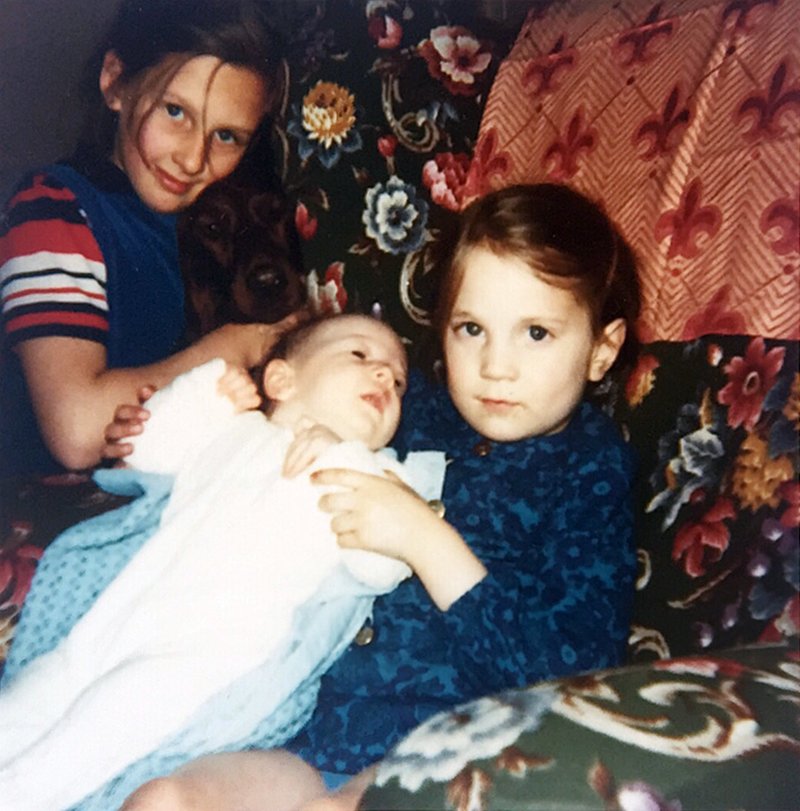How to Write With Intention
Ask yourself: What is your story about? Learn to write with purpose, with intention, with attention.
From front to back: Tanya holding baby sister, Aunt with our red-setter Kimmy. Photo: family archive, 1973
A Pale Blue Blanket
For your amusement, here’s another photograph from my family archive.
My photographer’s eye enjoys this picture for so many reasons. I have no memory of the event leading up to this photo. There's my sister laid carefully next to me on a pale blue blanket. I’ve clearly been told to hold her gently. My hands are relaxed. A little too relaxed. The baby might slip away from my gentle grip. There's my Aunt in the background cuddling our dog. And all those patterns. Big blowsy flowers covering the chair, flowers on my dress, stripes on my Aunt’s t-shirt. Oh, so nineteen-seventies.
Not long after this picture, I cut my little finger on my right hand. The keloid scar left behind is about four centimeters long. I tripped while carrying a glass. The glass shattered when I fell, a shard slicing open my little finger. Blood. Blood. Did I scream or cry? I don't remember. I do remember my Mum wrapping a towel or something similar tightly around my hand. My Dad took me to the army clinic where a doctor sewed the skin of my finger together with six neat stitches while I sat on my Dad's knee. My Dad remembers one big solitary tear rolling down my cheek.
~~~
This week, let's write with intent. Marion Roach Smith advises every writer to write with intent in her book The Memoir Project. What does she mean? Write with purpose, with in-tention, with at-tention. I'm still trying to get to grips with this. So don't worry if you're furrowing your brow right now wondering where this is going. You're not alone.
The question Smith wants us to ask ourselves is: What is this about?
“When first asked this question, beginning writers nearly always say something like “It’s about the day I went to the store when I was eight and bought a...” or, “I grew up in the nineteen-fifties, a time of...” and right there I have to cut them off.
What I am asking for is what the tale is about. What they are telling me is how they are going to illustrate the tale. I’m asking for the wrapper, and they are giving me the lozenge. I’m asking for the frame, and they are painting me the picture. I’m asking you to do the same.
What is your story about?”p.22, The Memoir Project by Marion Roach Smith
Let’s ask: What is this story about?
Perhaps it’s about the fact my Mum couldn't bring herself to take me to the army clinic. She was terrified by the state of my finger. My Dad took me. He was at home on leave at the time. The doctor said I was 'very brave, a soldier's daughter'. At least that's what I think he said. By the way, I am not brave but I am a soldier's daughter. That was why we were at the army clinic and not the hospital.
I do remember having the stitches pulled out a couple of weeks later and keeping them in a piece of tissue in a cupboard in the kitchen. It hurt having the stitches removed, the feeling of my skin being pulled as the thread moved through my tender healing skin.
In the end, I did have to go to the hospital where under a general anaesthetic a surgeon cut the skin where my finger meets my hand. Where the tight scar tissue had pulled my finger into a hook. Afterward, a nurse told me I couldn't have any ice cream until I'd eaten all my peas. I remember sitting on the edge of the bed in my nightie, dressing gown and slippers looking at a pile of peas rolling around on my plate and the ice cream slowly melting in the bowl next to them.
For you, for this week, have a rummage around your library of photos whether these are on your phone or in a physical album. Choose one preferably one of you taken by someone else. Look at the photograph. Ask yourself: What is this story about? Then write. Write with intent. Think about how you will illustrate your tale. It’s probably a good idea to keep the story about something small. You never know where it might take you.
Until next time.


